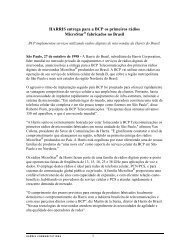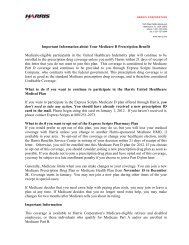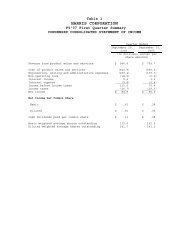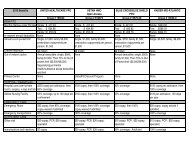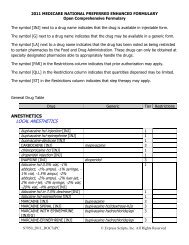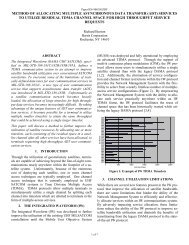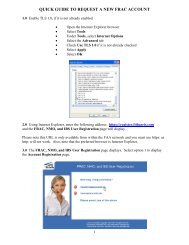harris corporation
harris corporation
harris corporation
You also want an ePaper? Increase the reach of your titles
YUMPU automatically turns print PDFs into web optimized ePapers that Google loves.
NOTES TO CONSOLIDATED FINANCIAL STATEMENTS (Continued)<br />
or increase to our unrecognized tax benefit balance during the course of the next twelve months as these<br />
examinations continue, other tax examinations commence or various statutes of limitations expire. An estimate of<br />
the range of possible changes cannot be made because of the significant number of jurisdictions in which we do<br />
business and the number of open tax periods.<br />
NOTE 24: FAIR VALUE MEASUREMENTS<br />
Fair value is defined as the price that would be received to sell an asset or paid to transfer a liability in the<br />
principal market (or most advantageous market, in the absence of a principal market) for the asset or liability in an<br />
orderly transaction between market participants at the measurement date. Further, entities are required to maximize<br />
the use of observable inputs and minimize the use of unobservable inputs in measuring fair value, and to utilize a<br />
three-level fair value hierarchy that prioritizes the inputs used to measure fair value. The three levels of inputs used<br />
to measure fair value are as follows:<br />
• Level 1 — Quoted prices in active markets for identical assets or liabilities.<br />
• Level 2 — Observable inputs other than quoted prices included within Level 1, including quoted prices for<br />
similar assets or liabilities in active markets; quoted prices for identical or similar assets or liabilities in<br />
markets that are not active; and inputs other than quoted prices that are observable or are derived principally<br />
from, or corroborated by, observable market data by correlation or other means.<br />
• Level 3 — Unobservable inputs that are supported by little or no market activity, are significant to the fair<br />
value of the assets or liabilities, and reflect our own assumptions about the assumptions market participants<br />
would use in pricing the asset or liability developed based on the best information available in the<br />
circumstances.<br />
The following table represents the fair value hierarchy of our assets and liabilities measured at fair value on a<br />
recurring basis (at least annually) as of July 1, 2011:<br />
Level 1 Level 2 Level 3 Total<br />
(In millions)<br />
Assets<br />
Marketable equity securities (1) ........................... $ 5.4 $— $— $ 5.4<br />
Deferred compensation plan investments: (2)<br />
Money market fund .................................. 27.9 — — 27.9<br />
Stock fund ........................................ 40.7 — — 40.7<br />
Equity security ..................................... 17.0 — — 17.0<br />
Foreign currency forward contracts (3) ..................... — 0.7 — 0.7<br />
Liabilities<br />
Deferred compensation plans (4) .......................... 85.8 — — 85.8<br />
Foreign currency forward contracts (5) ..................... — 0.9 — 0.9<br />
(1) Represents investments classified as securities available-for-sale, which we include in the “Other current assets” line item in our Consolidated<br />
Balance Sheet.<br />
(2) Represents investments held in a Rabbi Trust associated with our non-qualified deferred compensation plans, which we include in the “Other<br />
current assets” and “Other non-current assets” line items in our Consolidated Balance Sheet.<br />
(3) Includes derivatives designated as hedging instruments, which we include in the “Other current assets” line item in our Consolidated Balance<br />
Sheet. The fair value of these contracts was measured using a market approach based on quoted foreign currency forward exchange rates for<br />
contracts with similar maturities.<br />
(4) Primarily represents obligations to pay benefits under certain non-qualified deferred compensation plans, which we include in the<br />
“Compensation and benefits” and “Other long-term liabilities” line items in our Consolidated Balance Sheet. Under these plans, participants<br />
designate investment options (including money market, stock and fixed-income funds), which serve as the basis for measurement of the<br />
notional value of their accounts.<br />
(5) Includes derivatives designated as hedging instruments, which we include in the “Other accrued items” line item in our Consolidated Balance<br />
Sheet. The fair value of these contracts was measured using a market approach based on quoted foreign currency forward exchange rates for<br />
contracts with similar maturities.<br />
Assets and liabilities that were measured at fair value on a nonrecurring basis were not material during fiscal<br />
2011, 2010 or 2009, with the exception of impairments to goodwill and other long-lived assets as noted in Note 22:<br />
Impairment of Goodwill and Other Long-Lived Assets in these Notes.<br />
90




